Here‘s my step-by-step method for how to cook Japanese short-grain white rice in a rice cooker. Follow my rice-to-water ratio tips to make perfectly steamed white rice every time. No more mushy or dry rice!

The Japanese eat rice almost every day, sometimes 3 meals a day! Cultivated for thousands of years in Japan, rice occupies a significant place in the culture and is the quintessential staple of the Japanese diet. When it comes to the quality of the rice down to the cooking technique, we take every aspect seriously.
Today I will share how the Japanese cook white rice in a rice cooker. We also have a recipe for cooking rice on the stove.
Table of Contents
- What is Japanese Short-Grain Rice?
- My Favorite Japanese Rice Brands
- The Right Rice-to-Water Ratio for Short-Grain White Rice
- How to Cook Japanese Short-Grain Rice
- How Much Rice Do I Need to Cook
- Cooking Tips
- The Best Way to Store Cooked Rice
- Other Methods of Cooking Japanese Short-Grain Rice
- My Favorite Rice Cooker
- Delicious Rice Recipes
What is Japanese Short-Grain Rice?
Japanese white rice is a type of Japonica short-grain rice that is short, plump, and rounded oval.
In general, Japanese rice has a higher water content compared to long-grain varieties like basmati or jasmine rice. This means that Japanese rice is more tender and moist. It‘s also more sticky and chewy because the grains contain less amylose—a type of starch that separates rice grains—than long-grain rice.
It’s worth noting that outside of Japan, Japanese short-grain rice is often called “sushi rice” for marketing purposes. In reality, Japanese rice is typically used in everyday meals and less often in sushi recipes.
You may also notice that Japanese short-grain rice has been incorrectly called “sticky rice.” Sticky rice is actually another name for glutinous rice or short-grain Japanese mochigome. We use this type of glutinous rice to make Mochi, Sekihan, and Okowa.
👉🏻 To brush up on your knowledge, I highly recommend reading “Everything You Need to Know about Japanese Rice” and “Types of Japanese Rice.“
My Favorite Japanese Rice Brands
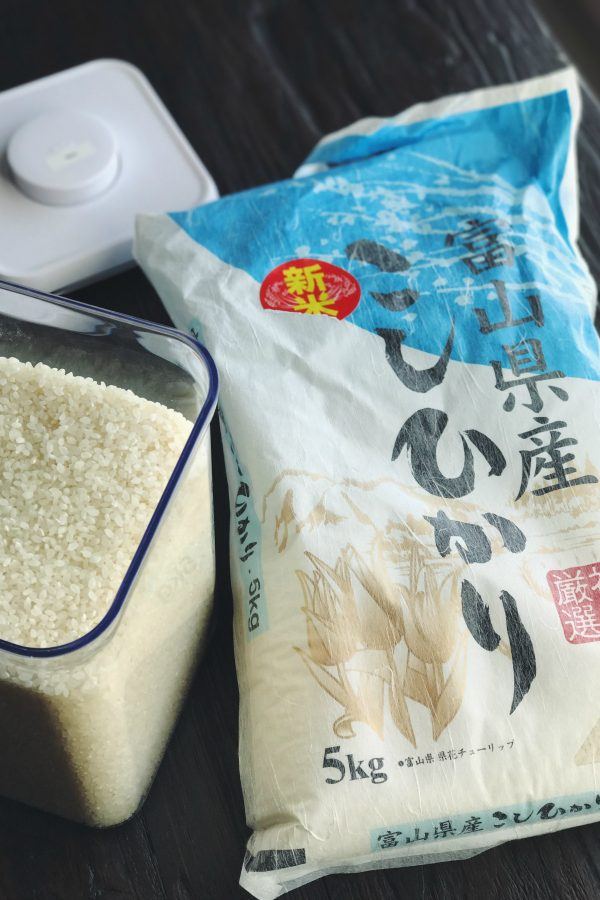

When it comes to high-quality Japanese rice, I would recommend the Koshihikari variety, which is available from various brands at Japanese grocery stores. Known for its sweet taste and fragrance, it is the most popular variety in Japan.
My family particularly likes koshihikari rice imported from Toyama prefecture (blue and white package).
The Right Rice-to-Water Ratio for Short-Grain White Rice

Over the years, I’ve received a lot of questions from my readers asking why their rice comes out dry.
And I think I know the reason.
Most online resources (in English) will tell you the rice-to-water ratio for Japanese short-grain white rice is 1 to 1.
But what you probably didn’t know is this:
The Japanese golden ratio for white rice to water is 1 to 1.1 (or 1.2).
That is 10-20% more water that you didn’t add! For example, one rice cooker cup (180 ml or ¾ US cup) of uncooked short-grain white rice will need 200 ml of water, not 180 ml.
That means, if you still want to use a “1-to-1 ratio,” the rice must be soaked in separate water for 20–30 minutes (to absorb an extra 10–20% of water) and drained well before you measure water at a 1-to-1 ratio. This way, you made sure your rice got the moisture it needed.
Most recipes online do not include that soaking step, which means the rice is missing the additional 10-20% of water.
Please note that the rice-to-water ratio is different for Japanese short-grain brown rice. To learn more, see my post How to Cook Short-Grain Brown Rice in a Rice Cooker.

So… Exactly how much water do you need for each rice cooker cup?
The plastic rice cooker cup that comes with the rice cooker is ¾ cup (180 ml). In Japan, this amount is called ichi go (一合). Here’s how much room-temperature water you need for each rice cooker cup of Japanese short-grain white rice when you follow the 1-to-1.1 (or 1.2) ratio:
1 rice cooker cup (180 ml) = add 200 ml of water
2 rice cooker cups (360 ml) = 400 ml
3 rice cooker cups (540 ml) = 600 ml
4 rice cooker cups (720 ml) = 800 ml
5 rice cooker cups (900 ml) = 1000 ml
Calculation: 180 ml x 1.1 (or 1.2) = 198 ml (or 216 ml)
Most Japanese rice cookers have a setting for white rice. If yours does, the inner pot will have marked lines for how much water to add for the number of rice cooker cups that you’re cooking. In this case, you can simply add your rinsed and washed white rice to the pot and pour water to the marked line.
My family and I actually prefer to add a bit more water than the water line in the rice cooker bowl for the imported Japanese rice we typically buy. Whenever we cook the rice according to the specified water line, the rice comes out a bit too dry. So, I highly encourage you to test and adjust the water amount whenever you switch the rice brand or the region where the rice is harvested.

How to Cook Japanese Short-Grain Rice
The Ingredients You’ll Need
- Japanese short-grain white rice
- Water (at room temperature)
The Cooking Steps
- Measure the Rice: Overfill your rice cooker cup (or US measuring cup) with uncooked rice, then level it off.
- Wash and Rinse: Start with an initial quick rinse, followed by washing and rinsing the rice three times. See the recipe card for my detailed step-by-step instructions and photos.
- Drain Well: Drain the rice very well in a fine-mesh sieve and shake off any excess water.
- Add Water: Add the drained rice and the measured water to the inner pot of your rice cooker.
- Soak the Rice: Very important! Soak the rice for at least 20–30 minutes.
- Select the White Rice Program: Most Japanese rice cookers have a setting for white rice.
- Cook: Press the Start button. The program on my rice cooker takes about 55 minutes from start to finish, including 10 minutes of steaming at the end.
- Steam: After cooking, let the rice steam for 10 minutes (if it’s not included in the program).
- Fluff and Serve: Insert a rice paddle vertically into the cooked rice. Turn over a scoop of rice from the bottom. Then, use a slicing motion to fluff the rice. Repeat until fluffed, then enjoy!
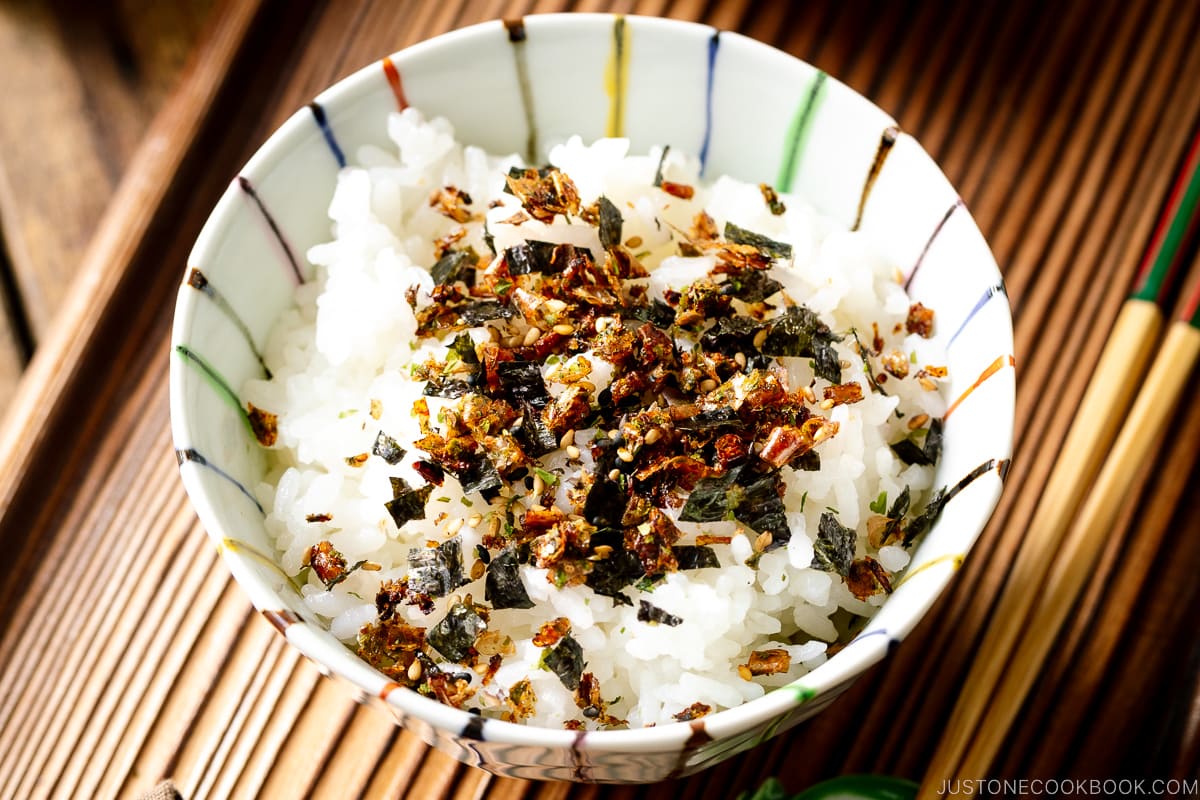
How Much Rice Do I Need to Cook
- 1 rice cooker cup (180 ml, ¾ cup, 150 g) of uncooked short-grain white rice
- 2¼ cups or 330 g of cooked rice
- 2 rice bowls
- 3 onigiri rice balls
- 1 donburi bowl
- 2¼ cups or 330 g of cooked rice
- 2 rice cooker cups (360 ml, 1½ cups, 300 g) of uncooked rice
- 4⅓ cups, 660 g of cooked rice
- 4 rice bowls
- 6 onigiri rice balls
- 2.5 donburi bowls
- 4⅓ cups, 660 g of cooked rice
- 3 rice cooker cups (540 ml, 2¼ cups, 450 g) of uncooked rice
- 6⅔ cups or 990 g of cooked rice
- 6 rice bowls
- 9 onigiri rice balls
- 4 donburi bowls
- 6⅔ cups or 990 g of cooked rice
- 4 rice cooker cups (720 ml, 3 cups, 600 g) of uncooked rice
- 8¾ cups or 1320 g of cooked rice
- 8 rice bowls
- 12 onigiri rice balls
- 5 donburi bowls
- 8¾ cups or 1320 g of cooked rice
- 5 rice cooker cups (900 ml, 3¾ cups, 750 g) of uncooked rice
- 11 cups or 1650 g of cooked rice
- 10 rice bowls
- 15 onigiri rice balls
- 6 donburi bowls
- 11 cups or 1650 g of cooked rice
Helpful Notes to Remember:
- One cup of cooked white rice weighs 5.3 oz (150 g).
- A typical rice bowl serving is 1 cup (150 g) of cooked white rice.
- A typical donburi bowl serving is 1⅔ cups (250 g) of cooked white rice.
- A typical onigiri (rice ball) weighs 110 g each.

Cooking Tips
- Always rinse and wash the rice. We always quickly rinse and wash the rice a few times. This is important to help remove impurities and the natural occurrence of arsenic on the rice.
- Short-grain rice always requires soaking (20–30 minutes), unlike other kinds of rice. The rice grains are rounder and fatter, so they need a head start to absorb moisture to the core of the kernel.
- Let the cooked rice steam for 10 minutes when the rice cooker turns off. Steaming is essential! It’s the final step in cooking Japanese rice. Without it, your rice will not cook fully. You can skip this step if your rice cooker program already includes 10 minutes of steaming time. Resist the urge to peek under the lid during this time! If you open the lid, you’ll release the precious steam that’s crucial for this resting period.
- When you use new crop rice (新米), reduce the water slightly.
- When you get a different brand of rice, test cooking the rice and adjust the amount of water, if needed
- The more rice you have in the pot, the more delicious your cooked rice will be. That’s because the most evenly cooked rice is in the center of the pot. The rice near the bottom and top simply cooks too fast. More rice in the pot means you’ll increase the central proportion of steamed rice for a more delicious outcome. That’s why I recommend cooking at least 2–3 rice cooker cups of uncooked rice at a time, even if you only need 1 cup. You can always freeze the extra rice with good results.
The Best Way to Store Cooked Rice
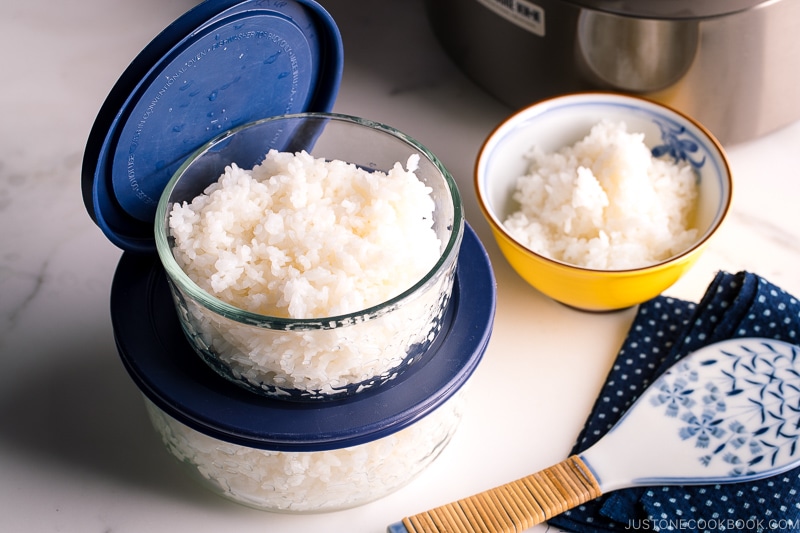
What’s the best method to store cooked rice? Simply freeze the rice in airtight containers and reheat to enjoy later on! This is by far the best approach to keeping your rice fresh and moist.
Other Methods of Cooking Japanese Short-Grain Rice


- How to Cook Rice in a Pot over Stovetop
- How to Cook Rice in an Instant Pot
- How to Cook Rice in a Donabe (Japanese Earthenware Pot)
My Favorite Rice Cooker
Those of us who live outside of Japan don’t have too many (fancy) choices. Since I came to the US, I’ve been using only Zojirushi brand rice cookers (3 of them).
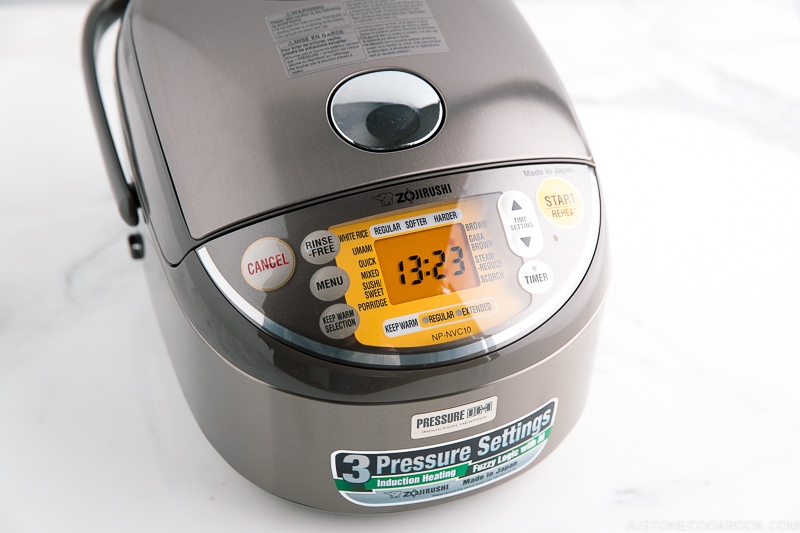
This is my current rice cooker by Zojirushi. It is a Zojirushi Pressure Induction Heating Rice Cooker & Warmer (5.5 cups).
As we eat rice at home almost every single day, I depend highly on a superior-quality rice cooker to cook the perfect rice for my family.
Zojirushi rice cooker uses pressurized cooking and AI (Artificial Intelligence) to cook rice. It also has a platinum-infused nonstick inner cooking pan that brings out the natural sweetness of the rice.
The other features include:
- Automatically selects from three pressure levels according to the menu selected
- Healthy cooking options: brown rice and GABA brown rice settings
- Menu settings include: white (regular, softer or harder), umami, mixed, sushi/sweet, porridge, brown, GABA brown, steam-reduce, scorch, rinse-free and quick cooking
- Made in Japan
With this rice cooker, I’ve never once needed to worry about dry or mushy rice. It is absolutely one of the must-have kitchen gadgets I can’t live without!
If you’re interested, you can purchase the rice cooker on Amazon.
Delicious Rice Recipes
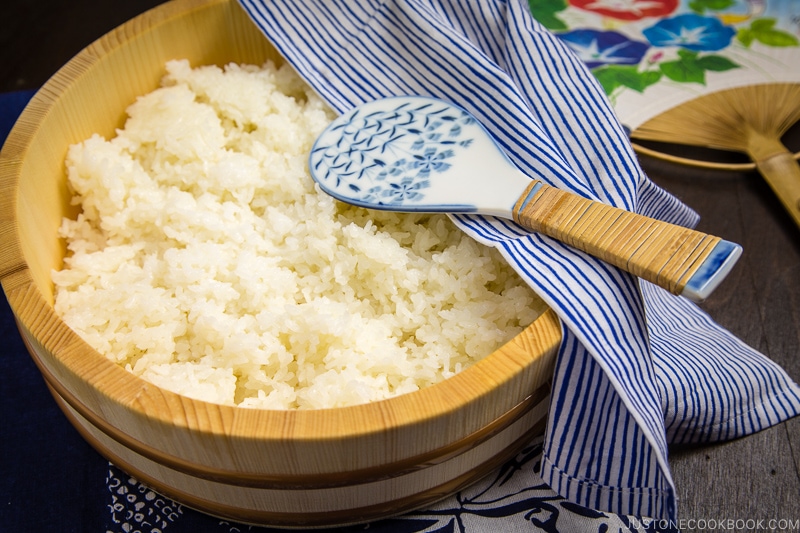
- How to Make Sushi Rice – You need sushi rice (seasoned rice) to make all kinds of sushi!
- How to Cook Short-Grain Brown Rice in a Rice Cooker
- Takikomi Gohan (Mixed Rice)
- 12 Donburi (Rice Bowl) Recipes
- Onigiri (Japanese Rice Balls)
- Shrimp Fried Rice
I hope you’ve found the above tips helpful. I’ve also included more topics on rice after the recipe below. If you have more questions, leave me a comment below!

Wish to learn more about Japanese cooking? Sign up for our free newsletter to receive cooking tips & recipe updates! And stay in touch with me on Facebook, Pinterest, YouTube, and Instagram.
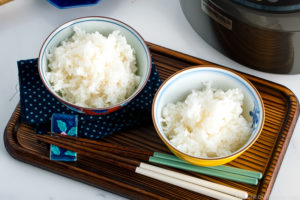
How To Cook Rice in a Rice Cooker
Ingredients
For 2 Rice Bowls (2¼ cups, 330 g cooked rice)
- ¾ cup uncooked Japanese short-grain white rice (1 rice cooker cup; 180 ml)
- ⅞ cup water (200 ml)
For 4 Rice Bowls (4⅓ cups, 660 g)
- 1½ cups uncooked Japanese short-grain white rice (2 rice cooker cups; 360 ml)
- 1⅔ cups water (400 ml)
For 6 Rice Bowls (6⅔ cups, 990 g)
- 2¼ cups uncooked Japanese short-grain white rice (3 rice cooker cups; 540 ml)
- 2½ cups water (600 ml)
For 8 Rice Bowls (8¾ cups, 1320 g)
- 3 cups uncooked Japanese short-grain white rice (4 rice cooker cups; 720 ml)
- 3⅓ cups water (800 ml)
For 10 Rice Bowls (11 cups, 1650 g)
- 3¾ cups uncooked Japanese short-grain white rice (5 rice cooker cups; 900 ml)
- 4⅛ cups water (1000 ml)
Instructions
Before You Start…
- Please note that Japanese short-grain white rice requires a soaking time of 20–30 minutes. The rice-to-water ratio is 1 to 1.1 (or 1.2) for short-grain white rice. Please read the blog post for a detailed explanation. ¾ cup uncooked Japanese short-grain rice is 1 rice cooker cup (150 g, 5.3 oz), which yields roughly 2¼ cups (330 g) of cooked rice. This is enough for 2 Japanese rice bowls (typically 150 g each) or 3 onigiri rice balls (typically 110 g each). 1 cup of cooked white rice weighs about 5.3 oz (150 g).
- To make Japanese brown rice, see my post How to Cook Short-Grain Brown Rice in a Rice Cooker.
To Wash the Rice
- Measure: Overfill a US cup measure (a ¾-cup measure works well for this) or a rice cooker cup with uncooked short-grain rice and level it off. Put the rice in a large bowl. Repeat until you have the measured amount of rice needed. Here, I‘m preparing 3 rice cooker cups (2¼ cups, 540 ml) of white rice.

- Quick Rinse: Add just enough water to the bowl to submerge all the rice. Then, discard the water immediately. Repeat one more time. Tip: Rice absorbs water very quickly when you start rinsing, so this step helps remove impurities from the rice and prevent it from absorbing the first few rounds of milky water.

- Wash: Next, use your fingers to gently agitate the wet rice grains in a circular motion for 10–15 seconds. Using very little water allows the grains to rub against each other. It also reduces the absorption of impurities from the milky water.

- Rinse: Add water and immediately discard the cloudy water. Repeat one more time.

- Repeat Wash and Rinse (steps 3 and 4) two more times.

- Drain: When the water is almost clear, drain the rice very well. Tip: Use a fine-mesh sieve to drain and shake off any excess water.

To Soak and Cook the Rice
- Transfer the well-drained rice to the inner pot of a rice cooker (I use the Zojirushi IH). Add the measured amount of room-temperature water (600 ml for my 3 rice cooker cups) to the pot. The water must not be warm or hot. Level the rice with your fingers so that it's evenly submerged in the water.

- Soak the white rice for 20–30 minutes (especially if you‘re using an older rice cooker). Then, select your menu and press Start. Tip: Even though my rice cooker includes soaking time, I still soak my white rice for 20–30 minutes before I start the cooker. Note: This Zojirushi rice cooker takes 55 minutes to cook 3 cups of Japanese short-grain white rice; the program includes 10 minutes of soaking time and 10 minutes of steaming time.

- When the rice is done cooking, let it steam for 10 minutes (if your rice cooker program does not include steaming time.) Open the lid and fluff the rice with a rice paddle.

To Store the Cooked Rice
- Transfer the rice to airtight containers and close the lid to keep the moisture in. Let it cool completely before storing the containers in the freezer (read my tutorial post).





















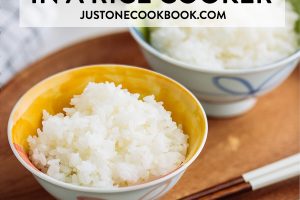
Hi Nami!
Thank you for your recipe and all your help!
Is it possible to cook non-Japanese rice in the rice cooker, such as Jasmine or Basmati rice? If so, what setting? My Zojirushi has White Rice, Mixed Rice, Brown Rice and Sushi Rice setting.
Thank you,
Alex
Hello, Alex. Thank you so much for reading Nami’s post!
If there is no jasmine rice setting, the Zojirushi website suggests using the white rice setting.
We hope this helped!😊
Thank you! i will check at the website 🙂
i have been using a rice cooker for many years. I got a zojirushi 6 cup rice cooker….i wash the japanese rice at least 5 times. Then I put it in the rice cooker and fill the water to the line of the amount of rice I’m cooking. I add a pinch more water and then let it soak till I cook it. However, it always gets brown on the bottom. What should I do?
Hi Ann, Thank you for taking the time to read Nami’s post!
We recommend starting with Nami’s recipe and using a 1:1.1 rice-to-water ratio. It’s possible that there wasn’t enough water and that the cooking water was less than what you needed when you started cooking the rice.
We hope this was helpful!🙂
We always preprogram the rice cooker which has the added benefit of ample soaking time.
Hi Stephen! What a great idea! Thank you for sharing your tip!
Hi Nami, I keep looking for the recipe or tips you shared on ig about one of the multi grain rice you add to your white rice in your household to make it more nutritious and tasty but I don’t know which type it is. I’m really excited to try what you do at home. Thank you so much!
Hi Jas! Thank you so much for reading Nami’s post and asking about multi-grain rice!
Currently, Nami is using these. She will share the recipes soon! So, please stay tuned!
https://amzn.to/3pcvMPA
https://amzn.to/44yIyIf
thank you for the great recipe ! As I only have less than an hour to prepare dinner from the time i get home from work, please advise if there is a way I can prepare this in advance. e.g. soaking or dry in the fridge (?) from morning. thank you !
Hi JOAN! Thank you for reading Nami’spost and trying her recipe!
Yes! You can prepare it in the morning. 🙂
Wash the rice and put them into the rice cooker inner pot, then add the measured water. Cover the inner pot with plastic wrap and place them in the refrigerator before you leave for work.
When you get home, take them out and set them up in the rice cooker to cook.
If your rice cooker has a “Quick cooking” setting, you can use the setting too. With this setting, the rice will be ready within 25~30 minutes!
You can also prepare the cooked rice ahead of time and save them in the freezer. At dinner time, you just need to defrost the frozen cooked rice in the Microwave and serve.
https://www.justonecookbook.com/how-to-freeze-rice/
We hope this is helpful.🙂
Thank you for the outstanding instructions! (I am a big fan of your site.) Ever since I first set foot in Japan, I have been pursuing the quest for the perfect rice. The rice we were served there even in the most humble restaurant beat what I made at home by a landslide. So, I bought a good Zojirushi rice cooker and discovered it was not enough. I experimented with water to rice ratios and discovered it was also not enough. Then, a Japanese friend told me to not just rinse, but also to polish the rice for 10 minutes. Big improvement, but it didn’t bring me all the way to the finish line. The last variables that I can experiment with are different brands (I have been using Nishiki and Kokuho Rose, so I need to branch out) and different water. Perhaps the water’s ph and mineral content make a difference? Have you experimented with rinse vs polish and possibly using bottled water?
Hi Luiz! Thank you for reading Nami’s post and for your kind feedback!
The rice quality/brand and type of water make a big difference in the texture and taste of the rice. It is just like bread comes out differently using different brands of flour. So try other brands and see how you taste.
Also, how you wash your rice makes a difference. The polished rice (grains rubbing against each other during the washing steps) surfaces have just enough to help absorb the good quality tasty water, so we hope you try Nami’s tips and instructions.
And yes! mineral content and pH would make a difference. The minerals adhere to the surface of the rice and prevent water absorption, resulting in dryer rice. For cooking Japanese rice, soft water is much better. If choosing bottled water, look for soft water.
FYI: Most Japanese water/tap water has a “pH value between 5.8 and 8.6” and soft water.
We hope this helps!🙂
Hi Nami 🙂
I have a Zojirushi with a preprogrammed Umami setting. Should I still soak the rice for 30 minutes prior to cooking when using this setting? Thanks for your help!
Hi Bernadette! Thank you very much for reading Nami’s post and trying her recipes!
Yes. Nami recommends presoaking the rice even for the pre-programmed setting.
We hope this helps!
Are there any adjustments for cooking rice (rice cooker, on stove, or whatever) at high altitude? I’m mile-high in Denver.
Thanks, Debbie
Hi Debbie! Thank you for reading Nami’s post and trying her recipes!
The boiling temperature of the water is different depending on the altitude level, so to use recipes, you will need to adjust the cooking time, heat level, and water amount. Nami lives close to sea level and has never tested recipes at higher altitudes before but found some helpful information for you.
We hope this helps.
https://www.fsis.usda.gov/food-safety/safe-food-handling-and-preparation/food-safety-basics/high-altitude-cooking#
As for the rice cooker, the Zojirushi website said;
All Zojirushi rice cookers are tested to function at an altitude of up to 5,000 feet above sea level. Pressure rice cookers are also not designed to cook at altitudes higher than 5,000 feet, but can cook the rice better at high altitudes (below 5,000 feet), compared to non-pressurized rice cookers.
https://www.zojirushi.com/app/faq/rice-cookers
And for Donabe, it should work fine, but to be sure, we recommend checking with the manufacturer.
Thank you for asking questions!